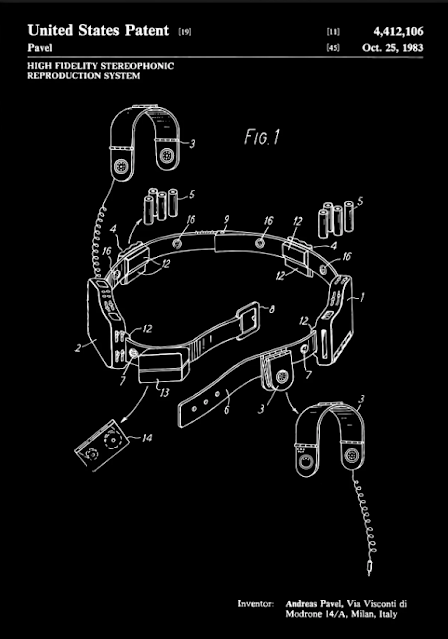© Mark Ollig
In Japan, July 1, 1979, the Sony Corporation began selling its portable, metal-cased, blue-and-silver model TPS-L2 cassette player, better known as the Sony Walkman.
Kozo Ohsone coined the term “Walkman” in describing the new lightweight cassette player a person can listen to while walking.
The Sony Walkman included lightweight headphones for hearing stereo audio from a cassette tape.
Two 1.5-volt AA batteries powered the Sony Walkman.
In 1980, the Sony Corporation began selling its portable cassette player in the US.
In Feb. 17, 1980, the Minneapolis Tribune newspaper advertised on page 12B the Sony Soundabout (Walkman) Model TPS-L2 for $188, which today, adjusted for inflation, would be $710.
In the US, Sony initially advertised the TPS-L2 as the Soundabout. However, it was named the Stowaway in the UK, and in Australia, they called it the Freestyle.
The first portable music device I owned was called the pocket transistor radio.
My former classmates may remember hearing music from the Panasonic AM/FM radio speaker I carried through the halls (and in the classrooms) at the Holy Trinity School in Winsted.
The first cassette tape recorder I had was a Christmas gift from my parents in 1971.
It included a dynamic microphone, volume and tape speed controls, a battery status display, a sound level monitor, and several 3.5mm audio jacks. It operated using batteries or when plugged into an AC outlet.
The cassette recorder was protected inside a black leather case with an attachable shoulder strap and a storage compartment to stow the microphone, earphones, and AC cord.
Folks my age will understand what I mean when saying, “always have a pencil handy when using cassette tapes.”
Fifty years ago, I purchased eight-track and cassette tapes, 45 rpm records, and LP (long playing) 33.33 rpm record albums at Roufs Pharmacy in Winsted, located across the street east from Security Bank & Trust Co.
We also ordered records and tapes through the mail after watching K-tel music television commercials.
To feel some nostalgia, watch this 1974 K-tel commercial selling “22 explosive hits on one great stereo LP record album for only $3.99,” at https://bit.ly/3B9Q9QK.
The Panasonic stereo system I bought in 1974 had dual-cassette tape drives. I could copy music to a blank cassette in the first tape drive from a vinyl record playing on the turntable, audio from the AM/FM radio, or audio from a pre-recorded cassette in the second tape drive.
I remember my grandparents’ wooden table radio and seeing the reddish glow of the vacuum tubes inside it. It may have been a model from the 1940s.
The wooden cabinet resembling a bedroom dresser with two doors housed the black-and-white television in our living room at home. This TV was from the 1950s.
Our family living room also had an RCA Victor “high-fidelity” upright wood cabinet phonograph player.
In 1971, my father bought the family a Zenith console cabinet AM/FM stereo radio with a built-in phonograph and eight-track tape player. He also purchased a new RCA XL-100 color television.
In those days, radios, phonographs, and televisions looked like living room furniture.
Fifty years from now, I wonder what today’s young people will think of their generation’s technology and devices for listening to music, watching television, and creating videos.
They may feel the same nostalgia some of us do.
The Sony Walkman became the most popular portable cassette player. However, someone created a compact and lightweight cassette player years before Sony did.
In 1972, Andreas Pavel, while living in Milan, Italy, designed, built, and tested a battery-operated portable radio-cassette stereo player attached to a belt that a person could wear around their waist.
He called it the Stereobelt.
Pavel also created lightweight headphones to wear while listening to his new device.
In March 24, 1977, Pavel filed Italian patent application number 21625 A/77.
In 1978, he filed a US patent application, serial number 889,664, titled “Stereophonic Production System for Personal Wear.”
In 1979, Sony Corporation began manufacturing and selling the model TPS-L2 portable cassette player, the Walkman.
Andreas Pavel then filed a lawsuit against Sony Corporation for stealing his invention and failing to compensate him.
The presiding judge ruled against Pavel, revoking his patent claim by stating his idea was “not significantly inventive.”
Pavel responded to the ruling by filing new lawsuits against the Sony Corporation.
In Oct. 25, 1983, Andreas Pavel was granted US patent number 4,412,106, titled “High Fidelity Stereophonic Reproduction System,” for his original portable cassette player invention.
Pavel also continued to file lawsuits against the Sony Corporation.
By 2004, Sony decided it was time to settle.
Andreas Pavel signed a confidential agreement that sources said paid him several million euros to dismiss years of legal lawsuits against the Sony Corporation.
“I filed my first patent thinking it would be a simple matter, 12 months or so, to establish my ownership and begin production [of his portable cassette player]. However, I never imagined that it would end up consuming so much time, and take me away from my real interests in life,” Pavel is quoted as saying.
In October of 2010, the Sony Corporation announced it had ended production of its classic Sony Walkman model TPS-L2, the cassette player we walked around with.
 |
| The Stereobelt by Andreas Pavel |
 |
| The Stereobelt by Andreas Pavel |
 |
| The Stereobelt by Andrea Pavel |
 |
| The Sony Walkman |
 |
| The Sony Model TPS-L2 "Walkman" |